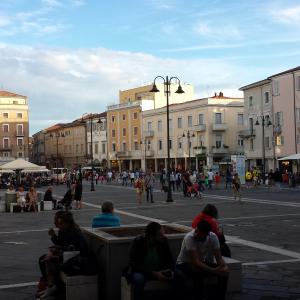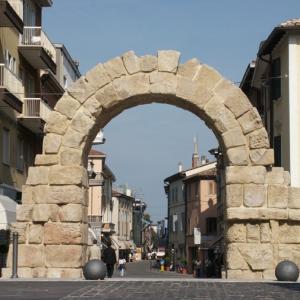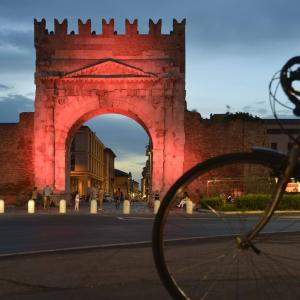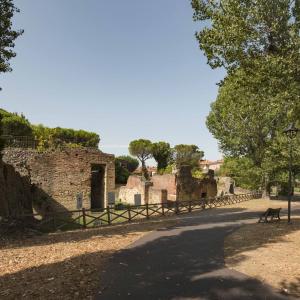Roman route in the historical center of Rimini
This route starts out from the Tiberius Bridge.
The Roman bridge over the Marecchia River, the ancient Ariminus around which the first settlement was built, still today creates the connection between the town and the suburb (Borgo San Giuliano). The bridge, begun by Augustus in 14 AD and completed by Tiberius in 21 AD, as the inscription that runs on the internal parapets recalls, stands out for its architectural design, the grandeur of the structures and the technique of construction.
Made of Istrian stone, it extends along in five arches that rest on massive pillars equipped with breakwater spurs and set obliquely with respect to the axis of the bridge, in order to support the current of the river thus reducing its force of impact, according to one of the most evident engineering devices.
We continue on towards the Town Museum (former Jesuit Convent).
The building that now houses the Museum, adjacent to the church built by the Jesuits between 1719 and 1740 in honor of Saint Frances Saverio, was built between 1746 and 1755 on a project by the architect Alfonso Torreggiani (1682-1764) as the "College” of the Jesuits.
In its courtyard it houses a Roman lapidary with inscriptions from the 1st century BC. to the 4th century AD. The museum has an archaeological section dedicated to imperial Rimini and houses the finds from the excavations of the Domus del Chirurgo (Surgeon's House) in Piazza Ferrari.
We now come to the excavation in Piazza Ferrari and the Domus del chirurgo (Surgeon's House).
The archaeological complex, which extends from the Roman Age to the Middle Ages, was discovered in 1989 during work on street furnishings.
The excavation, carried out by the Superintendence for Archaeological Heritage of Emilia Romagna in collaboration with the Municipal Museums of Rimini, brought to light a domus from the second half of the second century AD, built in an area already inhabited during the Republican Era, not far from the port of Ariminum.
Prestigious mosaics and lively frescoes describe a residence for private and professional use. Among the representative rooms the triclinium is quite noteworthy, as it is decorated with a mosaic with a large vase and, on the walls, frescoes and a refined glass panel depicting fish on the seabed. In the room with an elegant mosaic depicting Orpheus, a very rich surgical kit was found together with mortars for the preparation of drugs, connected to the owner's medical activity.
The materials found are exhibited in the nearby Town Museum.
The next stage is at the remains of the Roman Theater.
Of this imposing building for performances erected in the first century AD, only a few ruins remain today, incorporated into more recent buildings that trace the original curving shape of the steps (cavea).
Next to the forum, it was probably erected by the will of Augustus as part of the work on urban development promoted by the emperor.
Semi-circular in shape, it had an outer diameter of approximately 80 meters, while, inside, the length of the stage measured approximately 23 meters. The cavea, completely self-supporting, was shored up by radial and concentric walls, made of mortar with bare bricks. Access corridors covered by barrel vaults, made it possible to usher spectators towards the stairs that led to the bleachers.
Ruins of the Roman Amphitheater. It stood on the edge of the inhabited center of Ariminum, near the coastline, then further back than the current one. Elliptical in shape, it measured a total of 118x88 meters, while the arena had a width of 73x44 meters, not much different from that of the largest amphitheaters. Gladiator shows were held there which attracted huge audiences of at least 12,000 spectators.
Built in the 2nd century AD, as evidenced by Emperor Hadrian's coin found in some brickwork, it extended along two overlapping orders: the sober brick structure, which presented an external portico with 60 arches, must have created a great effect, especially for those coming from the sea. Now the two arches of the external portico, part of the arena and the cavea are visible.
The Arch of Augustus, the oldest preserved one in northern Italy, marks the entrance to the Town for those coming from the Flaminia, the road traced by the consul Flaminio in 220 BC to connect Rome to Rimini. Erected in 27 BC as an honorary door, it expresses the will of the Senate to celebrate the figure of Octavian Augustus, as manifested by the inscription placed above the arch. The monument was placed in the most ancient walls, of which, on its sides, the remains are visible, made of blocks of local stone. Today it is on its own, following the demolition of the adjacent buildings carried out in the 1930s. The entire structure is permeated by a strong religious character that underlines the sacred aspect of the town gate.
The itinerary continues in Piazza Tre Martiri.
This square follows part of the forum of Ariminum, a Roman colony founded in 268 BC: located at the intersection of the two main roads, the cardo and the decuman, the ancient layout, wider and extended up to via San Michelino in foro, was paved with large rectangular stones, now partially visible through fenced-off openings.
A sixteenth-century memorial stone recalls the speech that Julius Caesar supposedly addressed to the legions after passing the Rubicon: the square, which already bore its name, houses a bronze statue, a copy of a Roman original in commemoration of him.
A place of markets and therefore a living room of city life, the square now has the street furnishings that were created in 2000, aimed at enhancing the ancient layout and the signs of memory.
The most recent history links the square to the tragic war events: the memorial is given by the Monument to the Fallen and the name of the square itself, dedicated to the three partisan martyrs that were hanged there on August 16, 1944 at the point now marked by a marble insert.
The last stage is Porta Montanara.
The construction of this gate, also known as that of Saint Andrew, dates back to the 1st century BC and is part of an organic program of reorganization of the city’s defensive system, attributed to Silla. The round arch, made of sandstone blocks, was one of the two openings of the gate that allowed access to the town. Already in the early centuries AD, one arch was closed: the gate, thus reduced to a single archway, continued to mark the entrance to the town until the Second World War, during which it was partially destroyed.
It was reassembled in its original place.
Source: www.comune.rimini.it



